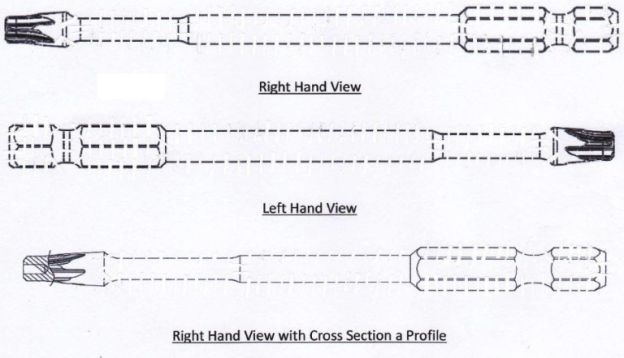Introduction
In Wynnes Patent and Trade Marks Attorneys Pty Ltd v Wamlez Pty Ltd [2023] ADO 3, the Australian Designs Office considered a third-party request to be heard in respect of the validity of certified design number 201712220 (the Design).
Before concluding that no grounds for revocation were made out, and that a certificate of examination should issue, the Hearing Officer was required to consider the scope of the Design in view of apparent discrepancies between (i) the drafting styles used in the representations, (ii) the statement of newness and distinctiveness (SoND), and (iii) the product name.
Background
The Design was filed by Wamlez Pty Ltd (Wamlez) on 18 April 2017. The title of the Design is "driver bit for fastener", and the SoND filed with the application reads as follows:
Newness and distinctiveness of the design resides in the shape and/or configuration of a driver as shown in the representations.
The representations utilise both solid and broken lines, and include the following:

Pursuant to s 63 of the Designs Act 2003 (Cth) (the Act), Crimesafe Security Systems Pty Ltd (Crimesafe) sought examination of the Design as a third party, asserting that the Design was not new and distinctive when compared to the prior art base.
The Examiner raised no grounds of revocation and on 16 March 2021, Crimesafe asked to be heard in respect of the Examiner's intention to issue a certificate of examination.
Interpretation of the Design
Before considering the prior art submitted in evidence, the Hearing Officer first considered the scope of the representations in the Design, including the effect of the solid and broken lines.
Crimesafe submitted that all matter indicated in the broken lines should be disregarded and that only the end portion of the product depicted in solid lines should be considered. Crimesafe supported this argument by interpreting the words in the product name, "driver bit for fastener", to indicate only the end distal portion of the overall thing pictured in the representations; that is, the part shown in solid lines. Wamlez countered this assertion by arguing that such a reading of the product name is not justified and that the Design should be read as being the overall thing shown in the representations.
The Act does not allow applicants to "claim" or "disclaim" parts of a whole thing, unless those parts are separable and permit assembly and disassembly. In light of this, it is common for applicants to include broken lines in representations with a corresponding SoND that directs particular attention be paid to specific visual features – typically those features shown in solid lines. The intended effect is to place more importance on the features shown in solid lines when comparing the representations to prior art designs.
Indeed, the Design Examiner's Manual of Practice and Procedure (the Manual) instructs examiners to, where elements in a representation are represented in a different manner, assume that the different styles have been included to make a point. The Manual also states that if there is doubt about the different styles used in a representation, the examiner should use other parts of the application (e.g., product name or SoND) to help understand what the difference means.
In the present case, in order to reach a conclusion about the effect of the broken lines in the representations of the Design, the Hearing Officer noted:
- there is nothing in the application showing that the elements depicted in solid lines are separable elements of the product;
- there is nothing in the SoND or otherwise that determines whether the features shown in broken lines or solid lines are the intended subject of the SoND; and
- the product is referred to as a "driver" in the SoND, which differs from the product name of "driver bit for fastener".
After considering submissions from both parties, the Hearing Officer concluded that the representations should be read as a whole and not in such a way as to completely disregard the matter shown in broken lines. In other words, the SoND in this case has the effect of directing particular regard to the shape and configuration of what is depicted in the representations overall, regardless of whether specific features are shown in broken or solid lines.
Following this interpretation, the Hearing Officer elected to read the product name, "driver bit for a fastener", as referring to the whole product in accordance with the viewpoint put forth by Wamlez. The Hearing Officer also noted that if he had, in accordance with the view of Crimesafe, interpreted the Design as being for the distal end portion only, then the assessment of newness and distinctiveness based on a comparison between the Design and the prior art may have turned out differently.
The Hearing Officer did not comment on the disconnect between the product title and the product mentioned in the SoND.
Decision
The Hearing Officer concluded that the Design was not substantially similar in overall impression to the relevant prior art submitted by Crimesafe, and therefore, no ground for revocation existed.
Conclusions
It has long been accepted that the comparison between representations of a design registration and the prior art is heavily reliant on how the representations are interpreted. Therefore, it is not particularly surprising that the Hearing Officer sought to interpret the representations before embarking on any assessment of validity. What is interesting, however, is the Hearing Officer's interpretation of the representations in light of the ambiguity introduced by inconsistencies between the drafting styles used in the representations, the SoND, and the product name.
This decision suggests that, where the SoND does not provide clear guidance as to how to interpret line styles used in the representations, the scope of the design will be interpreted as being the product shown in the representations without regard for the line styles used. Further, any discrepancies between the description of the product in the SoND (driver) and the product name (driver bit for fastener) may be overlooked and the broadest reasonable interpretation of the design will be used.
To avoid the uncertainty discussed in this decision, applicants should follow best practice and ensure that design applications include a SoND that supports the drafting styles used in the representations, and is consistent with the product name.
The content of this article is intended to provide a general guide to the subject matter. Specialist advice should be sought about your specific circumstances.



